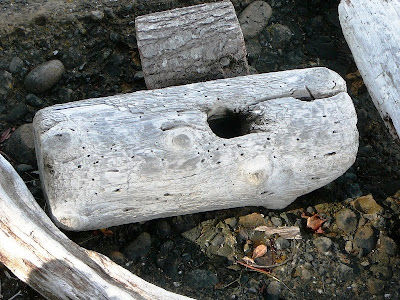
As a child growing up in the Pacific Northwest, log booms were a familiar sight. These were massive arrays of floating logs corralled by other logs linked together in a giant loop. These would be towed by tug boats to their destination of a lumber or paper mill, or perhaps to a port for transport across the seas.
Now, logs are shipped on enormous barges, entire forests stacked like cordwood, directly to foreign destination. Like many of our sawmills, log booms are a thing of the past. The boom heads (which had giant holes drilled in them to facilitate linking them together) were left to wash up on the shore, and many were cut up for firewood. The ends of the boom heads are a common sight on beach walks, and are also a popular folk art driveway marker or fencing feature. I came across all these on one 2 kilometre stretch of beach - considering that's a wee scrap of beach in all the Gulf Islands, and the Sunshine Coast, and Vancouver Island, there must be a heck of a lot of these out there.

















This is a painting of Ladysmith Harbour by E.J. Hughes, an artist who recorded scenes of Vancouver Island life from the 1930's to 2000.

I love the story of the log booms. Thanks.
ReplyDeleteI enjoyed the boom head photos too (especially since I need to re-immerse myself into past logging lore to finish my current writing project). The holes give the impression of watching eyes.
ReplyDeleteA classic E. J. Hughes painting from 1949 "Logs at Ladysmith". He lived and painted until he died in 2007 aged 93. Truly BC's greatest landscape painter, he painted a historical snapshot of British Columbia's coastal life.
ReplyDeleteYou can see more of his work at www.ejhughes.ca